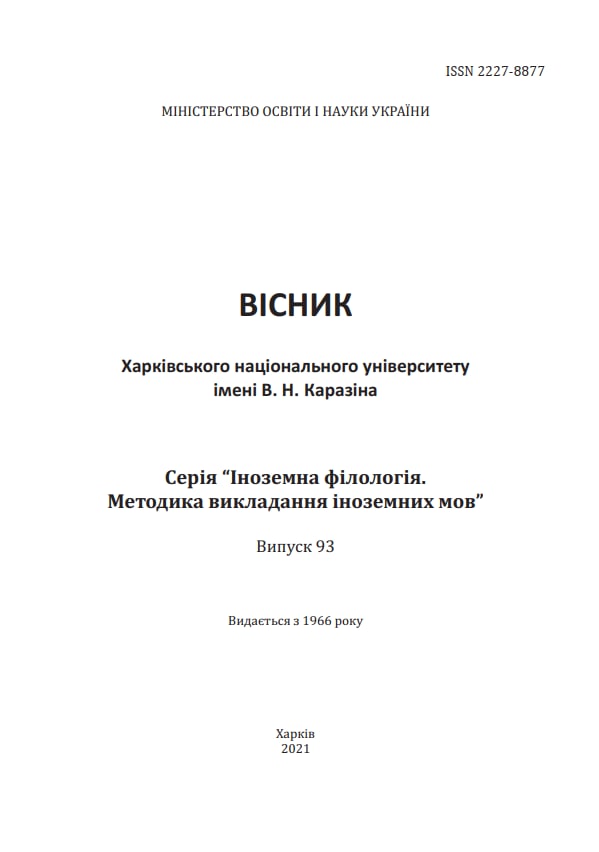Development of eptonymical signs in German quotations (based on the material of the COVID-19 thematic group)
Abstract
The article is devoted to the study of modern recurrent quotations in German (which function in printed media and, above all, on the Internet) on the subject of the appearance and development of eptonymous features in them. Eptonyms are understood as reproducible “winged” words/phrases/sentences (which are, in particular, aphorisms, maxims, and sententia) that implicitly appeal to the AUTHOR concept and tend to get phraseologized through derivational processes and the gradual loss of associative connection with their real author or precedent text. The relevance of the selected material is confirmed by the subject of the quotations studied, due to the central COVID-19 concept. The eptonym is separated from the broader of the related concepts, quotation, because of its explicit appeal to the AUTHOR concept. It is noted that eptonyms are characterized by fixedness, non-diffuse origin, expressiveness, conciseness (prerequisite for reproducibility), relevance of content, applicability in speech for a certain period of time, and a tendency to derivation. There are typical means of creating expressiveness in eptonyms; typical derivatives inherent in eptonyms in the process of their formation; typical concepts, by verbalizing of which eptonyms realize a categorial feature of the relevance of the topic. The analysis of the COVID-19 thematic group quotations showed that the reproduced quotations are either paradoxical in content, or appeal to valoratives, or are already the result of derivational processes. The phraseological/eptonymic identification algorithm used in this paper made it possible to distinguish potential eptonyms from other types of recurrent texts on the same topic, in particular, Internet memes. This algorithm was supplemented with techniques for analyzing creolized texts, including Internet memes. It was found out that Internet memes cannot claim eptonymic status due to the irrelevant accentuation of the AUTHOR concept. The findings show only the potential possibility of transition of quotations to the status of eptonym, because the condition of being time-tested has not yet been met for such quotations.
Downloads
References
Büchmann, G. (1907). Geflügelte Worte – Der Zitatenschaft des Deutschen Volks. Berlin: Haude & Spener.
Burger, H. (2003). Phraseologie. Eine Einführung am Beispiel des Deutschen. 2. Aufl. Berlin: Erich Schmidt Verlag GmbH & Co.
Djadechko, L. P. (2002) Krylatye slova kak objekt lingvisticheskogo opisanija: istorija i sovremennost' [Winged words as an object of linguistic description: history and modern state]. Kiev: KNU іm. Tarasa Shevchenka. (in Russian)
Duden. Zitate und Aussprüche. Bd. 12. (1993). Mannheim: Bibl. Institut & F.A. Brockhaus AG.
Fleischer, W. (1997). Phraseologie der deutschen Gegenwartssprache. Tübingen: Narr.
Freepik. Grafik-Ressourcen für jedermann. Abgerufen am 07.04.2021 von https://de.freepik.com/vektoren-premium/bleib-zuhause-ich-liebe-mein-land-beste
Koval`, A. P., & Koptilov, V. V. (1975). Kry`lati vy`slovy` v ukrayins`kij literaturnij movi. Afory`zmy`, literaturni cy`taty`, obrazni vy`slovy` [Winged phrases in Ukrainian literary language. Aphorisms, literary quotations, figurative phrases]. Kiev: Vy`shha shkola. (in Ukrainian)
Mackensen, L. (1985). Redensarten. Sprichwörter. Hanau: Verlag Werner Dausier.
Menzel, G., & Reuss, T. (2020). Mit Vernunft und Herz – Zu Vernunftappellen in der Corona-Krise. Blogreihe #8: Soziologische Impulse während Corona. Abgerufen von https://soziologieblog.hypotheses.org/13587
Morozova, O. (2017). Monomodal and multimodal instantiations of conceptual metaphors of Brexit. In Lege artis. Language yesterday, today, tomorrow. The journal of University of SS Cyril and Methodius in Trnava, II (2), December, 250–283.
Onishсhenko, N. A. (2013). Eptonimy` yak zasib formuvannya komunikaty`vnoyi kompetenciyi: kognity`vno-dy`skursy`vny`j pidxid [Eptonyms as a means of the formation of the FL communicative competence: the cognitive-discursive approach]. In V. G. Pasynok (Ed.), Suchasni fundamental`ni teoriyi ta innovacijni praktyky navchannya inozemnoyi movy u vuzi [Modern fundamental theories and innovative practice of teaching FL at higher school]. Kharkiv: V. N. Karazin Kharkiv National Univ. Publ. (рр. 191–218). (in Ukrainian).
Onishhenko, N. A. (2016). Osnovni kharakterystyky eptonimiv ta chynnyk avtora v procesi eptonimizaciyi ta deeptonimizaciyi (na prykladi nimecz'komovnykh eptonimiv J.-V. Gete). The main characteristics of eptonyms and the author's factor in the process of eptonymization and deeptonymization (on the example of German eptonyms by J.-W. Goethe). Visnyk Kharkiv. nats. un-tu im. V. N. Karazina. V.N. Karazin Kharkiv. National Univ. Messenger, 83, 128–136. (in Ukrainian).
Panasenko, N., Morozova O., Gałkowski, A., Krajčovič, P., Kryachkov, D., Petlyuchenko, N., Samokhina, V., … & Uberman, A. (2020). COVID-19 as a media-cum-language event: Cognitive, communicative, and cross-cultural aspects. In Lege artis. Language yesterday, today, tomorrow. The journal of University of SS Cyril and Methodius in Trnava. V (2), December 2020, 122–210.
Röttger, T. (2020). Meme – Warum die Veröffentlichung und Verbreitung von Meme im Internet (k)ein Problem ist. Gulden Röttger Rechtsanwälte GbR, 26. Juni. Abgerufen von https://ggr-law.com/urheberrecht/faq/meme-benutzen-veroeffentlichen-verbreiten-internet-urheberrecht-abmahnung/
Shkvarchuk, S. S. (2011). Eptonimy J. V. Gete: systemno-funkcional'nyj ta lingvokul'turologichnyj aspekty. (Dys. kand. filol. nauk) [Eptonyms by J. W. Goethe: systemic-functional and linguocultural aspect. (Philology PhD thesis)]. Chernivci: Yuri Fed'kovych National University. (in Ukrainian)
Shulezhkova, S. G. (2001). Krylatye vyrazhenija russkogo jazyka, ih istochniki i razvitie [Winged phrases in Russian, their origins and development]. Moskva: Azbukovnik. (in Russian)
Skupy, H.-H. (Hrsg.). (1993). Das große Handbuch der Zitate. 25000 treffende Aussprüche und Sprichwörter von A-Z. Güstersloh: Bertelsmann Lexikon Verlag.
Smolyana, T. A. (2017). Tekst nіmec'komovnoї maksimi: kognіtivno-diskursivnі aspekti. (Dys. kand. filol. nauk) The text of the German language maxim: cognitive and discursive aspects. (Philology PhD thesis)]. Kharkivskyi natsionalnyi universytet imeni V. N. Karazina, Kharkiv. (in Ukrainian)
So argumentieren Corona-Skeptiker – „Eines Tages wird es wieder verschwinden“. (28. Oktober 2020). Tagesanzeiger. Abgerufen von https://www.tagesanzeiger.ch/eines-tages-wird-es-wieder-verschwinden-665694595845
Spruch des Tages. Abgerufen am 07.04.2021 von https://www.spruch-des-tages.org
Spruchwelt. Abgerufen am 07.04.2021 von https://www.spruchwelt.com
Straftat aus Angst vor Corona. (20. März 2020). Kölner Stadt Anzeiger. Abgerufen von https://www.ksta.de/panorama/straftat-aus-angst-vor-corona-auto-fuer-16-rollen-toilettenpapier-aufgeknackt-36445090?cb=1615967699516
Tange, E. G. (1997). Lexikon der boshaften Zitate. Frankfurt am Main: Eichborn.
Tobler, A. (7. März 2020). Lachen über Corona: Die besten Witze im Netz. Tagesanzeiger. Abgerufen von https://www.tagesanzeiger.ch/kultur/diverses/so-lustig-ist-das-coronavirus/story/17130294
Trump und Corona: „Es wird einfach verschwinden“ (2.Oktober 2020). Süddeutsche Zeitung. Abgerufen von https://www.sueddeutsche.de/politik/corona-trump-usa-chronologie-1.4866980
Twitter. Suche nach Zitaten. Abgerufen am 7.04.2021 von https://twitter.com/search?q=%23zitate
Was ist ein Meme? Definition, Wirkung, Anwendung (2020). IONOS Digitalguide, 10. Dezember. Abgerufen von https://www.ionos.de/digitalguide/online-marketing/social-media/was-ist-ein-meme/




